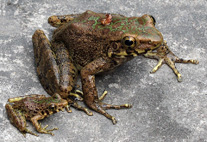Abstract
The genus Odorrana currently contains at least 56 recognized species that inhabits montane streams in subtropical and tropical Asia. Twenty new species have been described in the last decade, indicating the potential cryptic species diversity of this genus. We collected several specimens of Odorrana species from Southern China from 2007 to 2014, and on the basis of a combined morphological characters and phylogenetic analysis, we described the new species Odorrana fengkaiensis sp. nov. herein. The new species is very similar to O. hainanensis and O. bacboensis, but can be consistently separated by morphology, and allopatric distribution. It is further reciprocally monophyletic to O. hainanensis in a mitochondrial gene trees with an average genetic divergence of 2.1% (1.9%–2.4%). The new species inhabits in lowland broad streams, rivers, pools and near the riparian areas, but its general ecology remains poorly known. The new species is characterized by its body length of adult females approximately twice as long as adult males (SVL 77.8–111.9 mm in females, 37.4–51.8 mm in males); eye large in males, eye diameter 1.01–1.16 times as long as snout length; tympanum of males large and distinct, extremely close to the eye, 0.7–1.4 mm in tympanum-eye distance; dorsolateral folds absent; dorsal skin shagreened, with several large tubercles in males; flanks with tubercles and scattered larger pustules, 8–10 of which usually arranged in a dorsolateral row; ventral skin smooth, with spines in adult males during the breeding season; the tibio-tarsal articulation stretched forward beyond the tip of snout; relative finger lengths: II < I < IV < III; dorsum brown with irregularly reticulated green markings in males and young females, uniformly brown in some old adult females; males with velvety nuptial pad on thumb, paired gular pouches; mature oocytes almost purely black in life, showed dark grey animal pole and olive vegetative pole in preservative. In addition, we found O. bacboensis, a new country record from China, indicating a range extension from north-central Vietnam to southeast Yunnan and adjacent area in Guangxi.

